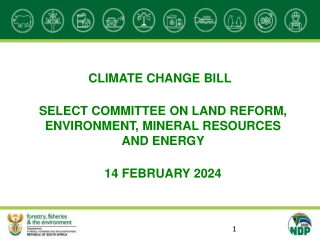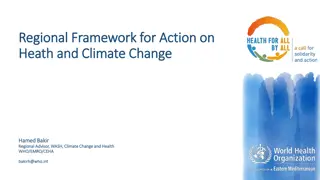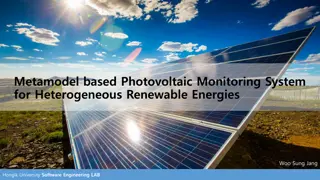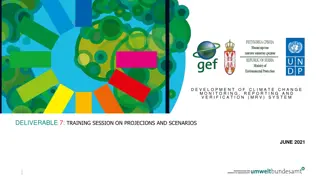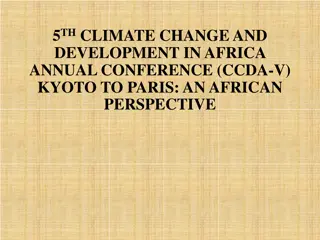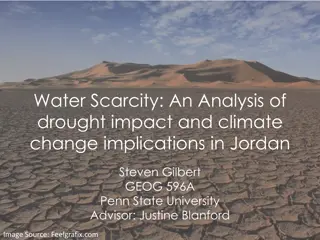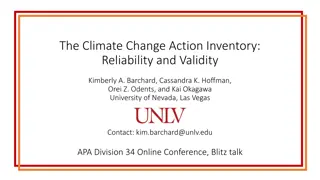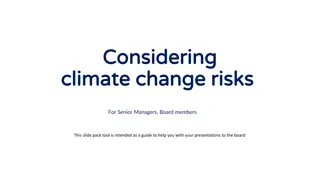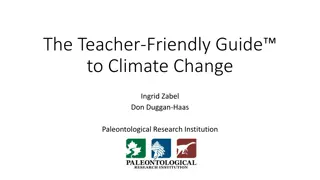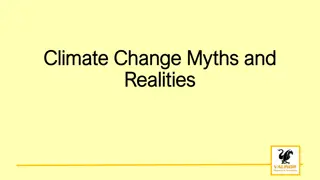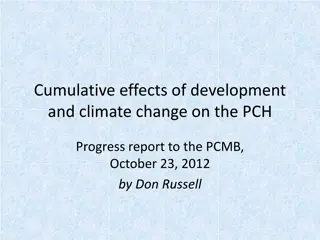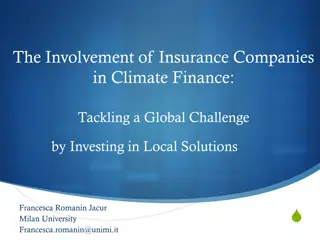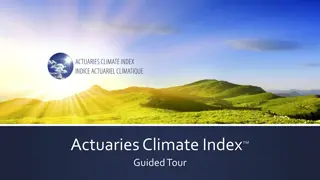
Development of Climate Change Monitoring and MRV System
Serbian Monitoring, Reporting, and Verification (MRV) System overview with 8 modules for comprehensive climate change monitoring, reporting, and verification. Anchored in national documents, the system ensures transparency for EU reporting and compliance with UNFCCC guidelines. The MRV-IT tool facilitates the preparation, monitoring, and reporting of low-carbon strategies, NDC planning, policies, GHG inventories, climate finance, and adaptation measures. Based on UNFCCC, EU, and Serbian regulatory frameworks, the system aims to meet international climate reporting standards effectively.
Download Presentation

Please find below an Image/Link to download the presentation.
The content on the website is provided AS IS for your information and personal use only. It may not be sold, licensed, or shared on other websites without obtaining consent from the author. If you encounter any issues during the download, it is possible that the publisher has removed the file from their server.
You are allowed to download the files provided on this website for personal or commercial use, subject to the condition that they are used lawfully. All files are the property of their respective owners.
The content on the website is provided AS IS for your information and personal use only. It may not be sold, licensed, or shared on other websites without obtaining consent from the author.
E N D
Presentation Transcript
D E V E L O P M E N T O F C L I M A T E C H A N G E M O N I T O R I N G , R E P O R T I N G A N D V E R I F I C A T I O N ( M R V ) S Y S T E M OVERVIEW OF 8 MODULES OF THE MRV IT TOOL DATA FLOWS, REPORTING FORMATS, INTER-INSTITUTIONAL COLLABORATION DECEMBER 14, 2021 ELISABETH RIGLER, TEAM LEADER
SERBIAN MONITORING, REPORTING AND VERIFICATION (MRV) SYSTEM Robust, efficient and purposeful MRV reporting system that fulfils the Paris Agreement transparency requirements and ensures the basis for EU reporting Anchored in two national documents Climate Change Law and the draft Climate Strategy with Action Plan Governance structure consists of eight reporting modules GHG Inventory, NDC, Projections and Scenarios, Policies and Measures (PAMs), Adaptation to Climate Change, Climate Finance, National Reporting and Indicators 2
MODULES OF FRAMEWORK FOR MONITORING, REPORTING AND VERIFICATION AT THE NATIONAL LEVEL MRV-IT system POLICIES& MEASURES NDC/LCDS/ LEDS National Reporting GHG INVENTORY MEP/ Secretariat for public policies MEP SEPA MEP Projections/ Scenarios Adaptation Action Indicators Climate Finance Secretariat for Public Policies/Ministry of Finance MEP MEP SEPA, MEP
MRV-IT TOOL SERVES FOR: 1. Preparation and monitoring of implementation of low carbon strategies; 2. Iterative process of NDC planning, monitoring and reporting 3. Reporting of policies, measures and projections of GHG emissions, change and climate finance; adaptation to climate 4. Establishing a national inventory system for estimating anthropogenic GHG emissions by sources and removals by sinks not controlled by the Montreal protocol, and for reporting and archiving inventory information; 5. Reporting to the UNFCCC and to the EU at the later stage. 4
Based on UNFCC, EU and Serbian regulatory frameworks: UNFCCC: Decision 18/CMA.1 Modalities, procedures and guidelines for the transparency MPG framework for action and support referred to in Article 13 of the Paris Agreement EU: Implementing Regulation Regulation (EU) 2018/1999 on EU Governance and the Implementing Regulation (EU) 2020/1208 on structure, format, submission process and review of information pursuant to Regulation (EU) 2018/1999 (EU) 749/2014. SERBIA: By-laws Zakon o klimatskim promenama (Law on Climate Change) 5
Based on UNFCC, EU and Serbian regulatory frameworks the MRV IT tool has a role to: be used as a reporting tool track progress towards meeting climate change related targets data storage and exchange information of newly stored data collect documents and reports of (comprehensive repository) MRV-relevance document 6
MRV IT tool will, through its components, enable: Data Acquisition Component: data processing Reporting Component: reporting; reporting function to provide data in tables and graphs for use in word document, PDF and spreadsheet reports; templates provided an partly pre-filled Collaboration Component: chats, emails, files Administration Component: administration and maintenance 7
DATA FLOWS Statistical Office NAP platform SEPA Activity data upload link Activity data download CRF upload Other data providers Adaptation Climate finance GHG inventory manual link manual Targets interface NDC CUDS Secretariat interface manual Projections link interface upload PaMs Ministry of Environment Ministry of Energy
INTER-INSTITUTIONAL COLLABORATION The MRV-IT tool enables raising the awareness about the reporting obligations towards the UNFCCC, the EU and the Serbian Climate Change Law It also raises awareness about the MRV system and the opportunities for improved sectoral cooperation, better informed policy making and public participation This particularly refers to other public institutions with climate-relevant policies and measures as well as IT systems that are already reporting on climate-relevant actions, such as the Secretariat for Public Policies, but also Institute for Statistics, Institutes for Nature Protection, Institute for Public Health, Hydrometeorological Institute, etc. Central role of the Environment Agency, in charge of the GHG Inventory Ministries of environment, energy, agriculture, transport, finance, interior, health, national and local administration contribute through the Secretariat or the Institute for Statistics Other actors, such as regional and local Institutes and bodies, also those involved with Covenant of Mayors, Chamber of Economy, Industry and public companies (waters, forestry, etc.), NGOs and Standing Conference of cities and towns have their role either as data providers or users 9
INTER-INSTITUTIONAL COLLABORATION MoEP and other ministries (scenarios, adaptation, PaMs, climate finance, NDC) SEPA (GHG inventory) Secretariate of Public Policies Local policies Data providers Other projects and databases (e.g. NAP) 10
SUMMARY MRV IT tool brings different actors of climate change related policy together and encourages cooperation and understanding of each other It contains all relevant information on MRV of climate change and is therefore a valuable depository for data, reports and other relevant documents It assists in fulfilling reporting obligations by providing relevant guidance and templates and by creating templates and graphs It tracks Serbia s progress in meeting its climate targets by presenting trends of past and projected emissions and indicators .AND . ...it is the only such tool we know of in Europe 11
PURPOSE: To collect and merge information on historic GHG emissions from 1990 onwards To enable Serbia to: fulfil its international reporting obligations according to the UNFCCC (MPGs) and the EU Governance and its Implementing Regulation perform a ex-post evaluation of its climate change policy by the use of indicators To provide list of activity data used for inventory preparation To visualise historic emissions trends (total and (sub-)sectoral) To make historic emission trends publicly available 13
GHG INVENTORY MODULE Prepared according to the principles set out in 2006 IPCC Guidelines for National Greenhouse Gas Inventories, transparency, accuracy, consistency, comparability, and completeness on biennial basis by the Serbian Environment Protection Agency (SEPA). Covers the period 1990-2019, with 1990 as the base year for the estimation and reporting of inventories Greenhouse gases reported on - CO2, CH4, N2O, HFC, PFC, SF6, NF3 Also four indirect GHG: SO2, CO, NMVOC, NOx IPCC sectors: Energy, Industrial Processes and Product Use (IPPU), Agriculture, Land Use, Land-Use Change and Forestry (LULUCF), and Waste. 14
GHG INVENTORY MODULE REPORTING REQUIREMENTS - SUMMARY UNFCCC: The modalities, procedures and guidelines (MPGs) for the transparency framework for action and support, referred to in Article 13 of the Paris Agreement are defined in Decision 18/CMA.1. MPGs para. 17 58: National inventory report of anthropogenic emissions by sources and removals by sinks of greenhouse gases: GHG Inventory (data set) and National Inventory Report (NIR) EU: Governance Regulation (EU 2018/1999) and Implementing Regulation (EU 2020/1208): Article 26: Annual reporting Article 37: Union and national inventory systems are fully in line with the Paris Agreement and MPGs Serbian Climate Change Law Article 57-61 GHG Inventory Articles 62 to 65: A system for reporting on policies, measures and GHG projections shall be set up, kept, continuously improved and reported to the UNFCCC Secretariat 15
PURPOSE To collect and merge information on climate mitigation projections and scenarios To assist and enable Serbia to fulfil its international reporting obligations according to the UNFCCC (MPGs) and the EU Governance and its Implementing Regulation To visualise projected emissions trends (total and sectoral) To make projections and scenarios publicly available 18
PROJECTIONS & SCENARIOS MODULE Input data: Scenarios (B2, M1-M4) as reported in Serbia s long-term strategy GHG emissions Economic parameters (GDP, labour force, GVA, consumption expenditure per household) Costs by policy/measure Modelling parameters Output files: EU Reporting templates, partly prefilled with available information Graphs: total and sectoral trends/scenario
PROJECTIONS & SCENARIOS MODULE PROJECTIONS & SCENARIOS MODULE REPORTING REQUIREMENTS REPORTING REQUIREMENTS - - SUMMARY SUMMARY UNFCCC: The modalities, procedures and guidelines (MPGs) for the transparency framework for action and support, referred to in Article 13 of the Paris Agreement are defined in Decision 18/CMA.1. paras 92 102: Projections of greenhouse gas emissions and removals EU: Governance Regulation (EU 2018/1999) and Implementing Regulation (EU 2020/1208): Article 39: Reporting on national projections Annex XXIII of the Implementing Regulation are fully in line with the Paris Agreement reporting by 15th March 2021 and every two years thereafter; substantial changes to the information shall be communicated annually Serbian Climate Change Law Articles 62 to 65: Projections of greenhouse gas emissions and removals, and reporting 20
Purpose collect and merge information on climate mitigation policies and measures enable Serbia to: fulfil its international reporting obligations according to the UNFCCC (MPGs) and the EU Governance and its Implementing Regulation monitor its progress towards its targets through a linking with the GHG inventory, the projections and the NDC module make policies and measures publicly available
POLICIES AND MEASURES (PAMS) MODULE IMPLEMENTATION Online questionnaire according to Article 37 and Annex XXIV of the Implementing Regulation (2020/1208) with predefined mandatory and optional fields additional national relevant fields (e.g. responsible person, comments, implementation roadmap, access to information - open to public or restricted etc.) Links within the MRV tool to projections: within the PAMs questionnaire it must be indicated whether the measure is considered within an emission scenario (e.g. WEM or WAM); a query e.g. of WEM or WAM measures only is possible 23
POLICIES AND MEASURES (PAMS) MODULE POLICIES AND MEASURES (PAMS) MODULE REPORTING REQUIREMENTS REPORTING REQUIREMENTS - -SUMMARY SUMMARY UNFCCC: The modalities, procedures and guidelines (MPGs) for the transparency framework for action and support, referred to in Article 13 of the Paris Agreement are defined in Decision 18/CMA.1. paras 80 90: Mitigation policies and measures EU: Governance Regulation (EU 2018/1999) and Implementing Regulation (EU 2020/1208) are fully in line with the Paris Agreement reporting by 15.March 2021 and every two years thereafter; substantial changes to the information shall be communicated annually The EU templates for reporting on Policies and Measures can be found under the Annex 9.8 of Impl. Regulation Serbian Climate Change Law Article 63 - 65: A system for reporting on policies, measures and GHG projections shall be set up, kept and continuously improved 24
PURPOSE To collect and compile information on adaptation to climate change that can be used for: fulfilling Serbia s international reporting obligations towards the UNFCCC (MPGs) and the EU Governance and its Implementing Regulation Evidence-based decision-making process make information on adaptation vulnerability, impacts and action publicly available
ADAPTATION MODULE PUBLICALY AVAILABLE DATA AND INFORMATION: Historical and projected climate data (National and Sub-national level) - NAP project EEA Indicators PAMs Adaptation + Adaptation Indicators (in Indicator part will be also) NDC Adaptation aa NDC document in NDC module Link with CSUD project Link with Loss&Damages DES_Inventar Documents: NAP, NC_Adaptation, LAPs, etc Templates: indicators and PAMs (planning&reporting)
ADAPTATION ADAPTATION MODULE REPORTING REPORTING REQUIREMENTS REQUIREMENTS - - SUMMARY MODULE SUMMARY UNFCCC: The modalities, procedures and guidelines (MPGs) for the transparency framework for action and support, referred to in Article 13 of the Paris Agreement are defined in Decision 18/CMA.1. IV. Information related to climate change impacts and adaptation under Article 7 of the Paris Agreement (para. 104-117) Also includes loss and damage EU: Governance Regulation (EU 2018/1999) and Implementing Regulation (EU 2020/1208) are fully in line with the Paris Agreement Reporting on adaptation actions: from March 2021, every 2 years, Annex VIII, Part 1. Serbian Climate Change Law Art. 6, and specifically Art. 13-15 28
PURPOSE To collect and compile information on climate finance that can be used for: Fulfilling Serbia s international reporting obligations according to the UNFCCC (MPGs) and the EU Governance and its Implementing Regulation Evidence-based decision-making process Making information on climate financing publicly available
CLIMATE FINANCE MODULE Article 9 of the Paris Agreement stipulates that developed country Parties shallprovide financial resources to assist developing country Parties. This support has to be reported transparently: provide transparent and consistent information on support for developing country Parties provided and mobilised through public interventions biennially. developed country Parties shall other Parties are encouraged to provide (transparent and consistent) information on support needed and receivedbiennially. developing country Parties should
CLIMATE FINANCE MODULE DOCUMENT REPOSITORY Share all available information on climate finance, e.g. - List of support needed from the Second National Communication / First Biennial Update report (available) - Analysis of climate-related expenditure in Serbia in the years 2016-2018 (available) - Future reports to the UN and the EU on support needed and received / provided Publish selected documents (transparency) 32
CLIMATE FINANCE CLIMATE FINANCE MODULE REPORTING REPORTING REQUIREMENTS REQUIREMENTS - - SUMMARY MODULE SUMMARY UNFCCC: The modalities, procedures and guidelines (MPGs) for the transparency framework for action and support, referred to in Article 13 of the Paris Agreement are defined in Decision 18/CMA.1. VI. Information on financial, technology development and transfer and capacity-building support needed and received under Articles 9-11 of the Paris Agreement (para. 130-145) EU: Governance Regulation (EU 2018/1999) and Implementing Regulation (EU 2020/1208) are fully in line with the Paris Agreement Currently not relevant for Serbia as requirements only refer to financial support (and technology development and transfer and capacity building) provided Serbian Climate Change Law Does not specifically mention this. 33
PURPOSE To monitor and visualise progress towards 2030 targets To make current version of NDC publicly available 35
NDC MODULE (INPUT PARAMETERS) The NDC module combines Data: Historic GHG emissions trends (1990-) from GHG emission module GHG emission scenarios (B2, M1-M4) from projection module NDC targets (relative, conditional) and tracks Serbia s progress towards meeting it s NDC target. Reports: NDC report
NDC MODULE NDC MODULE REPORTING REQUIREMENTS REPORTING REQUIREMENTS - - SUMMARY SUMMARY UNFCCC: The modalities, procedures and guidelines (MPGs) for the transparency framework for action and support, referred to in Article 13 of the Paris Agreement are defined in Decision 18/CMA.1. MPGs para. 59-103: III. Information necessary to track progress made in implementing and achieving nationally determined contributions under Article 4 of the Paris Agreement Additionally, Decision 4/CMA.1, Annex I clarity on NDC and Annex II accounting for NDC and Decision 6/CMA.1 common timeframe for NDCs and 9/CMA.1 on adaptation are also relevant EU: Governance Regulation (EU 2018/1999) and Implementing Regulation (EU 2020/1208): are fully in line with the Paris Agreement and MPGs Serbian Climate Change Law Only generally in Art. 3 on implementation of the Paris Agreement 37
PURPOSE To display NR-relevant policies and measures To display NR-relevant climate change adaptations 39
Thank you for your attention Contact: Elisabeth Rigler, Team Leader (Elisabeth.rigler@umweltbundesamt.at) Ivana Mijatovic, Transparency Expert (imijatovic005@gmail.com) 40


